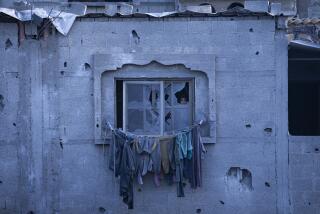Into the Sun Again
- Share via
The kid I knew allowed no laughter in his life and no light in his room. He spoke in hushed, whispery tones and kept the shades drawn. He talked of not wanting to live anymore, and woke up screaming from dreams of fire.
He said to me that when he lost his face in a flash of flame a long time ago he lost his identity too. Only a photograph that hung in the shadows of his apartment reminded him who he once was, but wasn’t anymore.
Mark Basham had vanished in a twinkling at age 12, and the kid who’d taken his place was a nobody burdened with sorrow and pain, scarred by fire and scorned by his peers.
He was, without question, the saddest and loneliest person I had ever met. But it’s different now.
I sing today of a new Mark Basham, a man of 27 who has stepped back into the light, who has resumed his life and who defies, with his very presence, those who once taunted him into isolation.
This Mark, this new Mark, can participate in the simple kinds of public activities he once avoided because they meant being seen, and being seen meant being hurt.
He rides buses, takes classes, goes to the beach and looks the world in the eye with a lion’s gaze of pride and defiance that says take me as I am, or don’t take me at all.
This new Mark Basham is a wonder, a man whose regenerated life reflects in everything he is and does, including the poetry he creates with meticulous care.
This new Mark Basham, who once hated the very necessity to awaken each day, can now laugh and write, “This can’t be heaven, / But it sure ain’t hell.”
Hell, however, is what it was 15 years ago in Kentucky when fire flashed through his family’s rented home.
Mark’s stepfather had used gasoline to remove glue that held carpeting in place. He left the room to light a cigarette. There was an explosion. . . .
The resultant fire killed Mark’s mother and brother and left him terribly scarred, emotionally as well as physically. His face, quite literally, had been burned away.
Mark’s stepfather disappeared. He was raised by other family members who kept him locked from view and finally threw him out. He ended up here, existing on government subsidies.
I wrote about him three years ago, when his life was a litany of almost unbearable anguish and humiliation.
“People don’t like to look at me,” he said then. “That’s a fact, and it hurts.”
He had undergone 100 skin grafts and 20 sessions of reconstructive surgery, but the scarring was still horribly apparent. He asked a doctor to put him to sleep.
He said to me, “I just can’t take the pain anymore.”
I didn’t know what to expect this time, but what I found was proof that the human spirit, no timid breeze, is a howling hurricane of a force that can blast away even the most wretched circumstances of our lives.
Mark plunged on through more reconstructive surgery, had his nose rebuilt, wears silicon ears, sports a mustache transplanted from his own scalp and begs no special mercies from the world.
“I can wear sunglasses now,” he said the other day in a newly refurnished Santa Monica apartment filled with sunlight.
The difference between this apartment and the one he occupied three years ago is the difference between home and a cell on Death Row.
“You don’t think about it, but when you haven’t got ears or the bridge of a nose, you can’t wear glasses.”
It was said in a tone of faint irony but there was triumph there, too. Whether it was specifically cosmetic surgery that encouraged Mark to step back into the world, he doesn’t know.
Single flash points that alter whole lives occur only in movies. Courage builds slowly. The kid became tired of the shadows. The man no longer feared derision.
“At some point,” Mark remembers, “I said to myself, if people don’t want to sit next to me on a bus, to hell with them. That’s their problem.”
Mark not only emerged from the shadows, but emerged with a willingness to help other burn victims. He regularly attends sessions of support groups. His strongest message is his very presence.
He says simply, “Look at me.”
Evidence that his life has turned around is contained in a picture on the wall of Mark taken before the fire . . . and next to it, for the first time, a picture of Mark today, with the ears and nose and mustache.
“I still get laughed at and it still hurts,” he said as he walked me to my car. “But they’ll never force me inside again. I’ll never look at the world from behind closed doors.”
As I drove away, he stood in full sunlight, waving. His smile said it was a glorious day to be alive.


